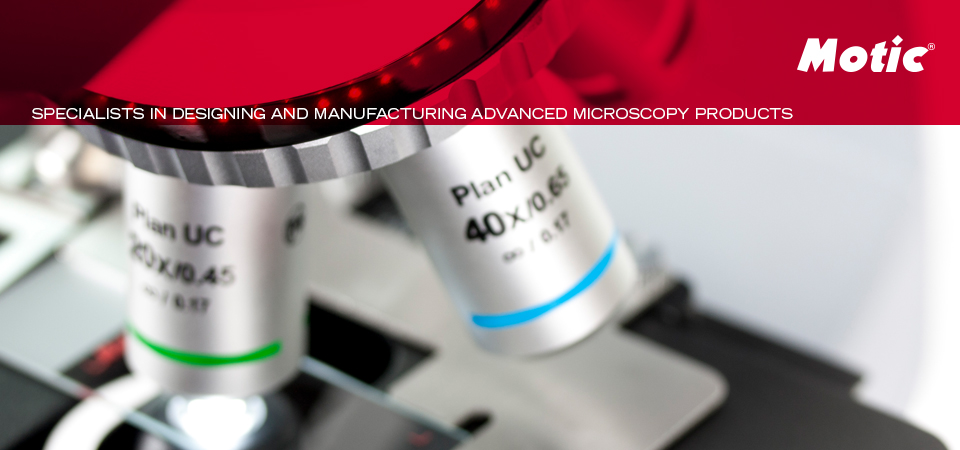Do not disassemble your microscope
Disassembly
may significantly affect the performance of the instrument, and may result in
electric shock or injury and will void the terms of the warranty.
Never
attempt to dismantle any parts other than the ones described below. If you
notice any malfunction, contact your nearest Motic supplier.
Optics
Keeping
the optics of your microscope clean is essential for obtaining clear images.
Choosing
the best cleaning method depends on the nature of the optical surface and type
of dirt.
Dirtiness on
the image may be caused by the following variables:
- Dirt on the outer or inner eyepiece lens.
- Dirt on the front lens of the objective.
- Dirt on the upper lens of the condenser.
- Dirt on the surface of the sample slide glass.
- Dirt on the upper lens of illuminator.
- Dirt on other optical components of the
microscope such as mirrors, lamps, filters, intermediate lenses …
In the case
of microscopes with a camera attached to it:
- Dirt on the
camera adapter.
- Dirt on the protection
filter of the camera sensor.
For Eyepieces
with reticules:
- Dirt on the
outer or inner reticle glass.
 |
| Dirt image | Clean image |
Objectives
are the optical component of the microscope that require the most maintenance.
Because for their actual use, they can get dirty easily.
For
objectives that work without oil (dry): The first step is to carefully unscrew the
objective from the nosepiece.
In order to
make things easier and safer, we can screw the objective on one of the objective
cases supplied with microscope. By doing it this way, the objective will be in
a stable position avoiding possible falls.
1 We will proceed by cleaning it using
pressurized dry air - or an air gun if available – and, if after this is done we
still observe spots of dust or dirt, 2 we will clean them with a cotton swab
dampened with a low graduation of alcohol 70% or with a mixture of alcohol and
ether (ratio
alcohol: 3 and ether: 7). 3 With a spiral movement (starting from the center of
the lens) we will then clean the surface of the lens. 4 We will then dry its
surface by using pressurized dry air and we will check that the lens is clean either
with the help of a magnifying glass or by screwing the lens back on the
revolving nosepiece of the microscope.
For
objectives that work with immersion oil it is essential to clean them after each
observation session. To clean it we will use a cleaning cloth for lenses
slightly dampened with a low graduation of alcohol. We will proceed by cleaning
the frontal objective lens (normally 100X-Oil or 50X-Oil). It is important to make
a preventive maintenance also for those objectives that work at a very close
distance to the sample. With this we mean the 40X and 60X objectives, which may
accidentally get in contact with the immersion oil.
Users of
inverted biological microscopes have to take special care with the objectives because
they can get dirty with dust or liquid that spills from the sample/s. In this
case we recommend you check the status of the objectives accurately at least
once a week.
For optical
components such as eyepieces, condensers, filters, etc. we recommend using the
same cleaning method. First cleaning it with pressurized dry air, then cleaning
it with a cotton swab or a cleaning cloth for lenses (slightly moistened with a
low graduation of alcohol) and finally drying it with pressurized dry air.
Once the
cleaning process is finalized if the image is still not clear, you can either
contact us or you can contact your
Motic supplier.
For users
that have a digital camera mounted on the microscope and whom observe dirt on
the digital image, it is important that the first step is to proceed with
objectives maintenance, as explained above. If the dirt persist, we have to
find out if it has to do with the microscope or the camera. To check this we
simply have to loosen the adapter and rotate the camera. If the dirt rotates
whilst turning it, then it means that it is in the microscope. If it does not
rotate, then it is either in the adapter or in the protection filter of the
sensor. If the dirt is on the surface lens of the adapter then you can use the
same cleaning method that we have explained above, but if the dirt is in the
protection filter of the sensor then use pressurized dry air only. If the dirt
persist you can either contact us or
you can contact your Motic supplier.
Mechanics
The mechanical
components of the microscope require less maintenance than the optical
components. Our first maintenance advice is to use the dust cover provided with
the microscope, this way we will avoid the accumulation of dust on the
microscope.
If we wish
to clean the stand or the specimen holder, we will simply use a cleaning cloth
moistened with soap diluted in distilled water. After this we will proceed in
perfectly drying the entire surface of the microscope. You have to take special
care with the electrical components of the microscope such as the ON / OFF
switch, the dimmer, the lamp holder…
If there are
grease stains we can use the same cloth moistened with a low graduation of
alcohol.
If you face
any problems related to the maintenance of your microscope, please contact us. Our
technicians will gladly help you solve your maintenance issue/s.












